- K-State home
- College of Architecture, Planning and Design
- About
- News and Events
- Ekdahl Lecture History
- Ekdahl Lecture History
Ekdahl Lecture History
All lectures are presented with sustained support from the Ekdahl family.
Ekdahl Lectures 1974
Title: The Age of Modesty
Archibald C. Rogers FAIA (1917–2001)

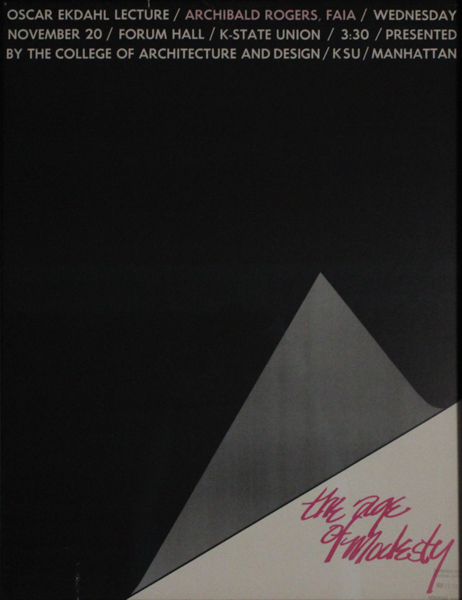 Archibald Coleman Rogers was an American architect and urban planner, notable for his influential practice in Annapolis and Baltimore, Maryland from 1946 to 1976. He was the founder of the architectural firm later known as RTKL Associates and served as the president of the American Institute of Architects (AIA) in 1974.
Archibald Coleman Rogers was an American architect and urban planner, notable for his influential practice in Annapolis and Baltimore, Maryland from 1946 to 1976. He was the founder of the architectural firm later known as RTKL Associates and served as the president of the American Institute of Architects (AIA) in 1974.
Early Life and Education
Archibald Coleman Rogers was born on September 29, 1917, in Annapolis, Maryland, to William Coleman Rogers and Margaret (Bryan) Rogers. He attended Princeton University, where he earned a Bachelor of Arts in 1939 and a Master of Fine Arts in 1942. For a brief period in 1939-1940, he worked for the architectural firm Cross & Cross in New York City.
Military Service and Early Career
During World War II, Rogers served in the Naval Reserve from 1942 to 1946. After his service, he returned to Annapolis and opened his own architectural office. In 1949, he formed a partnership with Francis T. Taliaferro, known as Rogers & Taliaferro. The partnership expanded in 1956 to include Charles E. Lamb and again in 1961 to include George Kostritsky. As the firm grew, Rogers and Kostritsky specialized in urban planning.
Major Projects
Rogers led several significant urban planning projects, including:
- Charles Center, Baltimore (1962)
- Redevelopment plan, Hartford, Connecticut (1962)
- Downtown plan, Cincinnati (1966)
- Downtown plan, Eugene, Oregon (1966)
- Fountain Square, Cincinnati (1968)
- Downtown plan, Jacksonville, Florida (1972)
The firm also completed architectural projects such as the Church of the Redeemer in Baltimore and the Dorsey College Center of Goucher College, in collaboration with renowned architect Pietro Belluschi. In 1969, the firm was incorporated as RTKL Associates and relocated its main office to Baltimore. Rogers retired in 1977 but continued as a consultant into the 1980s.
Advocacy and Leadership
In 1946, Rogers was appointed zoning commissioner for Anne Arundel County. He advocated for sound planning principles, often clashing with county commissioners, leading to his resignation in 1952. In 1955, James Rouse selected him as the first executive director of the Greater Baltimore Committee, an organization aimed at revitalizing central Baltimore. Although he served for only a year, he played a crucial organizational role.
In 1956, Rogers led the Urban Design Concept Team, responsible for planning the routes of interstate highways through Baltimore. He was known for opposing highway routes that would harm the city's urban fabric.
Professional Involvement and Recognition
Rogers joined the AIA in 1946 as a member of the Baltimore chapter. He served as chapter president and participated in several national committees before being elected first vice president/president-elect in 1973 and president in 1974. In 1967, he was elected a Fellow of the AIA. After his presidency, he was honored with honorary memberships in the Royal Architectural Institute of Canada and the Society of Architects of Mexico.
Archibald C. Rogers passed away in 2001, leaving a legacy of significant contributions to architecture and urban planning.
Ekdahl Lectures 1975
Peter Blake, FAIA (1920-2006)
 Peter Blake, born Peter Jost Blach, was a prominent architect, curator, and writer who significantly influenced modern architecture and design. Born into a Jewish family in Berlin in 1920, Blake was sent to England for schooling after the Nazis came to power. His parents later emigrated separately from Germany.
Peter Blake, born Peter Jost Blach, was a prominent architect, curator, and writer who significantly influenced modern architecture and design. Born into a Jewish family in Berlin in 1920, Blake was sent to England for schooling after the Nazis came to power. His parents later emigrated separately from Germany.
Education and Early Career
In 1938, Blake began his studies at the University of London and in 1939 enrolled at the Regent Street Polytechnic School of Architecture. Around 1940, he moved to the United States, where he continued his architectural education at the University of Pennsylvania. There, he studied under and briefly worked for the renowned architect Louis Kahn. He became a U.S. citizen in 1944 and changed his surname to Blake. After serving in the U.S. Army until 1947, Blake settled on Long Island, where he formed lasting friendships with influential figures such as Jackson Pollock, Philip Johnson, Robert Motherwell, Willem de Kooning, and Charles Eames.
Career Highlights
From 1948 to 1950, Blake served as the curator of architecture and design at the Museum of Modern Art (MoMA), where he authored books on iconic architects like Marcel Breuer, Frank Lloyd Wright, Le Corbusier, Mies van der Rohe, and Philip Johnson. He joined Architectural Forum magazine, where he worked as associate editor from 1950 to 1961, managing editor from 1961 to 1964, and editor-in-chief from 1965 to 1972. In 1972, he founded Architecture Plus, a visually stunning but short-lived magazine that ceased publication in 1975.
Blake also collaborated with Julian Neski to design the architecture exhibition at the American National Exhibition in Moscow, famous for the Nixon-Khrushchev Kitchen Debate.
Academic and Later Career
In 1975, Blake became Dean of the Boston Architectural Center. In 1979, he took on the role of Dean of the Department of Architecture and Planning at Catholic University in Washington, D.C. He was a partner in the architectural firms PB & Julian Neski from 1958 to 1961 and James Baker & PB from 1964 to 1972. His notable architectural projects include the Temple Emanu-El in Livingston, NJ.
Writing and Legacy
Despite designing around 50 buildings, Blake is best remembered for his influential writing. His extensive body of work includes:
- The Master Builders: Le Corbusier, Mies van der Rohe, Frank Lloyd Wright
- A History of Modern Architecture: God's Own Junkyard
- The New Forces
- Architecture for the New World: The Work of Harry Seidler
- Great Architecture of the World
- Form Follows Fiasco: Why Modern Architecture Hasn't Worked
- Architecture for the New World - The Architecture of Arthur Erickson
- Edward Larrabee Barnes: Architect
- Philip Johnson
- Craig Ellwood, Architecture
- How to Design the Perfect Building
- The Architecture of Ulrich Franzen
Blake colorfully recounted his life in his 1993 memoir, No Place Like Utopia: Modern Architecture and the Company We Kept. His archives are preserved at Columbia University.
Peter Blake's long and illustrious career left an indelible mark on modern architecture, both through his built work and his extensive writings. He passed away in 2006, survived by his wife, Petty Blake.
Geoffrey Broadbent (1929-2020)
Geoffrey Broadbent was an influential English architect, academic, and author renowned for his contributions to architectural theory, particularly in the field of semiotics. He served as the head of the School of Architecture at Portsmouth Polytechnic (later the University of Portsmouth) from 1967 until 1994, after which he was named professor emeritus. Among his most notable works are Design in Architecture: Architecture and the Human Sciences (1973) and Emerging Concepts in Urban Space Design (1990).
Early Life and Education
Geoffrey Broadbent was born on June 11, 1929, in Huddersfield, Yorkshire, England, to Albert and Florence Broadbent. He pursued architectural studies at the University of Manchester, completing his education in 1955.
Career
Broadbent began his professional career as an assistant architect at Fairhursts in Manchester (1956-1959). However, his passion lay in academia. He held several lecturer positions: at the University of Manchester (1959-1961), the Institute of Advanced Architectural Studies (IAAS) at the University of York (1961-1962), and the University of Sheffield (1963-1967). In 1967, he was appointed head of the School of Architecture at Portsmouth Polytechnic, a role he held until his retirement in 1994, when he was made professor emeritus.
Throughout his career, Broadbent held numerous influential positions, including chairman of the Portsmouth Society (1974-1988) and membership in various committees related to education within the Royal Institute of British Architects, the Royal Society of Arts, the Design Research Society, and the British School at Rome.
Personal Life
Geoffrey Broadbent was married to Anne Barbara Broadbent until her death in 1985. The couple had two children, Mark John Broadbent and Antony James Broadbent. In 1991, he married Gloria Camino Maldonado. Broadbent passed away in Portsmouth in 2020. In his honor, an annual memorial lecture was established, the inaugural lecture titled "Thinking Architecture" was delivered on November 17, 2022, by Dr. Richard Bunt. Broadbent’s extensive personal library was bequeathed to the Portsmouth School of Architecture.
Contributions to Architectural Theory
Broadbent was a pioneering figure in architectural theory, aligning architecture with humanities and psychology, and later focusing on semiotics. His seminal book Design in Architecture: Architecture and the Human Sciences (1973) dissected the architectural design process into four major phases: pragmatic, iconic, analogic, and canonic. This work was praised for its focus on the human aspect of environmental design.
His bibliography includes significant publications:
- Design in Architecture: Architecture and the Human Sciences (1973)
- Neo-classicism: Schinkel, Johnson, Stirling (1979)
- Meaning and Behaviour in the Built Environment (1980)
- Signs, Symbols and Architecture (with Richard Bunt and Charles Jencks, 1980)
- Emerging Concepts in Urban Space Design (1990)
- Tomás Taveira (1991)
- Deconstruction: A Student Guide (1991)
- Free Spirit in Architecture - Omnibus Volume (with Andreas Papadakis and Maggie Toy, 1992)
- Eco-Architecture: Harmonisation Between Architecture and Nature (with C.A. Brebbia, 2006)
- Eco-Architecture II: Harmonisation Between Architecture and Nature (with C.A. Brebbia, 2008)
Geoffrey Broadbent's extensive work in architectural theory and his academic leadership have left a lasting impact on the field of architecture.
Title: Land Use: Fiery Issue
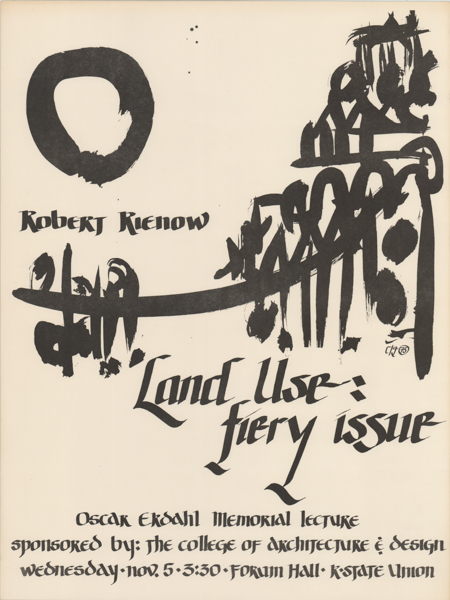 Robert Rienow (1907-1989)
Robert Rienow (1907-1989)
Robert Rienow was an American political scientist, environmentalist, and author known for his contributions to the field of environmental policy and for his advocacy for environmental conservation. He served as a professor at the State University of New York at Albany (SUNY Albany) and co-authored influential works that brought attention to ecological issues long before they were widely recognized.
Early Life and Education
Robert Rienow was born on March 27, 1907, in New York. He pursued higher education at Columbia University, where he earned his Bachelor's degree in 1929, followed by a Master's degree in 1930. Rienow continued his academic journey at Columbia, obtaining a Ph.D. in Political Science in 1935.
Academic Career
Rienow began his teaching career at SUNY Albany, where he became a respected professor of political science. His academic interests extended beyond traditional political science to encompass environmental issues, a relatively novel focus at the time. His interdisciplinary approach helped lay the groundwork for the modern field of environmental policy.
Environmental Advocacy
Robert Rienow's passion for the environment was evident in both his academic work and his activism. Alongside his wife, Leona Train Rienow, he co-authored several books that highlighted the pressing need for environmental conservation. Their most notable work, Moment in the Sun (1967), offered a stark warning about the consequences of environmental neglect and overpopulation. This book was one of the early popular texts to draw public attention to the environmental crisis, preceding the first Earth Day in 1970.
Major Works
Rienow's contributions to literature and environmental discourse were significant. Some of his major works include:
- Moment in the Sun (1967) - Co-authored with Leona Train Rienow, this book explored the ecological challenges facing the planet and called for immediate action to address environmental degradation.
- Of Snuff, Sin, and the Senate (1935) - A satirical take on American politics, reflecting his keen observations of political systems and behaviors.
- Our New Life with the Atom (1959) - Another collaborative work with Leona Rienow, examining the impact of nuclear technology on society and the environment.
Legacy and Impact
Rienow's work in environmental advocacy was pioneering, influencing future generations of environmentalists and policy-makers. His efforts contributed to the early environmental movement and helped shape public awareness and policy regarding ecological issues. The foresight and urgency in his writings underscored the importance of sustainability and responsible stewardship of natural resources.
Personal Life
Robert Rienow married Leona Train Rienow, a fellow author and environmentalist. The couple's partnership extended into their professional lives, where they co-authored several influential works. Rienow passed away on March 4, 1989, leaving behind a legacy of environmental consciousness and academic excellence.
Conclusion
Robert Rienow's contributions to political science and environmentalism have had a lasting impact. His interdisciplinary approach and early advocacy for environmental issues helped pave the way for the modern environmental movement. Through his teaching, writing, and activism, Rienow emphasized the importance of addressing ecological challenges and inspired future generations to continue the fight for a sustainable future.
Ekdahl Lectures 1976
Peter Q. Bohlin (1937 - Present)
 Peter Q. Bohlin is an esteemed American architect celebrated for his innovative and contextually responsive designs. Born in New York City in 1937, Bohlin is a founding principal of the renowned architectural firm Bohlin Cywinski Jackson (BCJ). His distinguished career has earned him numerous accolades, including the 2010 Gold Medal from the American Institute of Architects (AIA), one of the highest honors in the profession.
Peter Q. Bohlin is an esteemed American architect celebrated for his innovative and contextually responsive designs. Born in New York City in 1937, Bohlin is a founding principal of the renowned architectural firm Bohlin Cywinski Jackson (BCJ). His distinguished career has earned him numerous accolades, including the 2010 Gold Medal from the American Institute of Architects (AIA), one of the highest honors in the profession.
Early Life and Education
Peter Bohlin was born into a creative environment in New York City. His early exposure to the arts and architecture fostered a passion that would define his career. Bohlin pursued his architectural education at Rensselaer Polytechnic Institute, where he earned a Bachelor of Architecture in 1958. He furthered his studies at the Cranbrook Academy of Art, where he received a Master of Architecture degree. In recognition of his contributions to the field, Bohlin was inducted into Rensselaer's Alumni Hall of Fame in 2011.
Professional Career
In 1965, Bohlin co-founded the firm Bohlin Powell in Wilkes-Barre, Pennsylvania. The firm later evolved into Bohlin Cywinski Jackson, with offices expanding to six locations: Wilkes-Barre, Pittsburgh, Philadelphia, Seattle, San Francisco, and New York City. Under Bohlin's leadership, BCJ became known for its thoughtful and site-sensitive designs, merging innovative architecture with the natural environment.
BCJ was honored with the AIA Firm Award in 1994, recognizing the firm's consistent excellence and contributions to architecture. Bohlin's influence extended beyond his firm, as he served as a guest design critic and visiting professor at various architecture schools, sharing his expertise and inspiring future generations of architects.
Notable Projects
Peter Bohlin's portfolio includes a wide range of projects, from public buildings and educational facilities to private residences and iconic retail spaces. Some of his most notable works include:
- Grand Teton National Park Discovery and Visitor Center: Jackson, Wyoming
- Seattle City Hall: Seattle, Washington
- Liberty Bell Center: Philadelphia, Pennsylvania
- Pixar Animation Studios & Headquarters: Emeryville, California
- Thomas M. Siebel Center for Computer Science: University of Illinois
- Numerous Apple Stores: Including flagship locations on Fifth Avenue in New York City, Regent Street in London, and Carrousel du Louvre in Paris
His residential projects are equally distinguished, such as the Ledge House in Maryland and the Envelope House in Washington.
Awards and Honors
Peter Bohlin's contributions to architecture have been widely recognized. His honors include:
- 2010 AIA Gold Medal: Awarded for his significant impact on the theory and practice of architecture.
- Nine AIA Honor Awards: Celebrating excellence in design.
- 2008 AIA COTE Top Ten Green Project Award: For the Pocono Environmental Education Center.
- 2008 AIA Pennsylvania Medal of Distinction
- 2006 Honorary Doctoral Degree: Conferred by Rensselaer Polytechnic Institute.
- 2004 RPI Alumni Key Award: Recognizing outstanding alumni contributions.
- 1994 RPI Thomas W. Phelan Fellows Award
Publications
Peter Bohlin's work has been extensively documented in various publications, including:
- Bohlin Cywinski Jackson: The Nature of Circumstance (2010)
- Grand Teton: A National Park Building (2009)
- Farrar: Bohlin Cywinski Jackson (2007)
- Liberty Bell Center: Bohlin Cywinski Jackson (2006)
- Arcadian Architecture: Bohlin Cywinski Jackson: 12 Houses (2005)
- Ledge House: Bohlin Cywinski Jackson (1999)
- The Architecture of Bohlin Cywinski Jackson (1994)
Legacy
Peter Bohlin's architecture is characterized by its sensitivity to context, innovative use of materials, and harmonious integration with the natural environment. His work continues to inspire architects and students, leaving a lasting legacy in the field of architecture. Through his designs, teaching, and publications, Bohlin has significantly shaped contemporary architectural practice, emphasizing the importance of creating spaces that resonate with their surroundings and users.
Title: Architecture: A Manifestation of Values

Professor Partick Quinn

Emeritus Professor Patrick Quinn is a distinguished figure in the realm of sacred space design, religious architecture, and scholarly exploration of art and spirituality. His recent achievement includes being awarded the 2022 Outstanding Achievement Award by the Architecture, Culture, and Spirituality Forum (ACSF), recognizing his significant contributions to advancing the mission of the ACSF across various fields such as architecture, landscape architecture, art, design, urbanism, planning, and related disciplines.
Hailing from Ireland, Quinn received his education at University College Dublin before pursuing further studies at the University of Pennsylvania Graduate School of Design, where he was mentored by the renowned architect Louis Kahn. Throughout his career, Quinn's focus has been on designing spaces that hold deep spiritual significance. His architectural creations have garnered accolades such as the AIA National Design Award and Liturgical Conference Awards, and they have been featured in prominent publications worldwide, including Art d’Eglise, Liturgical Arts, Faith & Form, Architectural Record, Progressive Architecture, Kunstliche Kunstblatter, among others.
Quinn's academic journey includes teaching roles at the University of California, Berkeley, followed by serving as Dean of the School of Architecture at Rensselaer Polytechnic Institute (RPI) and later as Institute Professor of Architecture until 1996, after which he became RPI Institute Professor Emeritus. He has held esteemed positions such as national president of the Association of Collegiate Schools of Architecture and has been recognized with awards like the Rome Prize in Architecture. His global influence is evident through his Fulbright Senior Lectureship at CEPT University in Ahmedabad, India, and his engagements as a visiting professor and critic at universities worldwide, where he has shared his insights on sacred architecture, design, and art with diverse audiences.
Quinn's scholarly contributions extend beyond his architectural practice. He is a prolific writer, with his works on religious architecture and art published in multiple languages across various countries. Currently, he serves as an editor for The Cambridge Guide to the Architecture of Christianity, slated for release by Cambridge University Press. In celebration of his ACSF award, Quinn is set to deliver a lecture at the ACSF’s 2022 symposium at Fallingwater, designed by Frank Lloyd Wright, in June.
The ACSF, of which Quinn is a longstanding supporter, believes in the power of design and built environments to contribute to spiritual development and address global challenges. Through its international platform, the ACSF fosters scholarship, education, practice, and advocacy focused on the cultural and spiritual significance of architecture and the built environment. More information about ACSF and its mission can be found at acsforum.org.
Ekdahl Lectures 1977
Ann Ferebee (1932 - 2021)
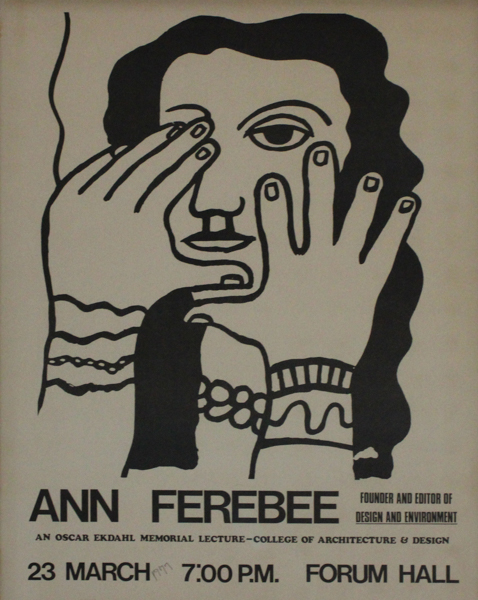

Ann E. Ferebee, a pioneering journalist, author, and historianAnn's journey through life was marked by a relentless pursuit of new ideas and a deep passion for design, history, and urban planning.
Early Life
Ann's academic journey began at the Norfolk Division of the College of William and Mary before she ventured to New York City, where she graduated from Barnard College. While at Barnard, she delved into American literature but also cultivated interests in photography and design history, setting the stage for her multifaceted career.
Career
After graduation, Ann joined Time, Inc. as a researcher while pursuing further studies at the Institute of Fine Art. Her teaching career in design history took root at the Pratt Institute, where she imparted knowledge to aspiring designers. She also made significant contributions to academia through her work at the Parsons School of Design.
A pivotal moment in Ann's career was the founding of Design and Environment, a magazine she launched and led as editor-in-chief. This publication became a platform for exploring landscape architecture and public space design, reflecting Ann's deepening engagement with urban environments.
Legacy
In 1979, Ann's vision for a collaborative platform in urban design led to the establishment of The Institute for Urban Design, where she served as director until 2004. This institute became a global hub for architects, designers, planners, and thinkers, fostering interdisciplinary dialogues and organizing forums in cities worldwide.
Throughout her career, Ann's insatiable curiosity led her to interview numerous luminaries in the arts and humanities, including Andy Warhol, James Baldwin, and Marshall McLuhan. Her global travels allowed her to track emerging trends in art and design, enriching her perspective and contributions to the field.
Ann's legacy is one of innovation, collaboration, and a profound impact on the realms of design, history, and urban planning. Her passion for exploring new ideas and fostering dialogue continues to inspire generations of thinkers and creators.
Title: Environmental Anthropology: The Architecture of Place
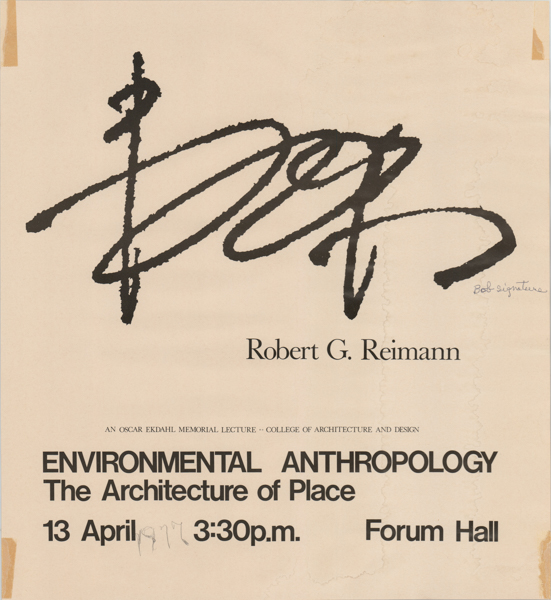 Robert G. Reimann (October 13, 1928 – April 25, 2009)
Robert G. Reimann (October 13, 1928 – April 25, 2009)
Esteemed dean, landscape architect, and educator based in Cazenovia, New York.
Early Life and Education:
Born in White Plains, New York, Robert, known as Bob, was the only son of George S. and Ellen T. Reimann. After graduating from Cardinal Hayes High School in 1946, he served in the Navy until 1949. Bob's passion for landscape architecture led him to pursue higher education, earning a Bachelor of Science degree in landscape architecture from SUNY College of Environmental Science and Forestry in 1954.
Career and Achievements:
Bob's career in academia began in 1962 when he joined the faculty at SUNY College of Environmental Science and Forestry. He ascended to the role of dean of the School of Landscape and Architecture, a position he held from 1976 to 1984, demonstrating his commitment to education and leadership in the field.
As a practitioner, Bob co-founded the Reimann-Beuchner Partnership in 1969, leaving an indelible mark on the landscape architecture profession. His designs can be found throughout the state and region, reflecting his deep connection to the land he cherished.
Legacy and Contributions:
Bob's professional contributions are extensive and impactful, shaping the landscapes and minds of many. His dedication to his craft and mentorship of future generations earned him the title of professor emeritus upon his retirement in 1998.
Ekdahl Lectures 1978
Malcolm Wells (March 11, 1926 – November 27, 2009)
An influential American architect known as "the father of modern earth-sheltered architecture." He resided on Cape Cod, Massachusetts, in a modern earth-sheltered building of his own design, embodying his innovative approach to sustainable living.
Career and Contributions:
Malcolm Wells was not only an architect but also a versatile creative figure. He began his career in architecture and design in 1953, initially working in conventional architecture for ten years. However, he soon became disenchanted with what he saw as the excessive paving over of natural landscapes in the name of development. This realization led him to pioneer underground architecture as a more harmonious and sustainable alternative.
Wells' dedication to energy efficiency, aesthetics, land preservation, and durability of materials defined his architectural philosophy. His semi-underground offices in Cherry Hill, New Jersey, were a testament to his commitment to integrating buildings with their natural surroundings.
As a writer, Wells authored several influential books that explored his ideas and techniques. His works, including "How to Build an Underground House" and "Passive Solar Energy: The Homeowner's Guide to Natural Heating and Cooling" (co-written with Bruce Anderson), have sold over 120,000 copies, highlighting his impact on popularizing sustainable architecture.
Legacy and Advocacy:
Even after retiring from formal architecture in 2004, Wells remained a vocal advocate for underground living and sustainable design until his passing in 2009. His advocacy extended beyond architecture, encompassing topics such as solar energy, land restoration, and innovative approaches to construction.
Personal Life and Family:
Malcolm Wells was survived by his wife, Karen North Wells, and son, John Wells. His legacy continues through his pioneering work in earth-sheltered architecture and his ongoing influence on sustainable design practices.
Bibliography:
Malcolm Wells' bibliography reflects his diverse interests and expertise:
- How to buy solar heating ... without getting burnt! (1978)
- The Children's Solar Energy Book (1982)
- Underground Designs (1981)
- Classic Architectural Birdhouses and Feeders (1988)
- Architects Sketchbook of Underground Buildings: Drawings and Photographs (1990)
- How to Build an Underground House (1991)
- Infra Structures (1994)
- Passive Solar Energy: The Homeowner's Guide to Natural Heating and Cooling (with Bruce Anderson) (1996)
- Sandtiquity (with Kappy Wells, Connie Simo) (1999)
- Designing Your Natural House (with Charles G. Woods) (1999)
- Recovering America: A More Gentle Way to Build (2001)
- A Tiny Underground House
- Bipad (1995)
- Underground Plans Book (1980)
- Liquid Gold: The Lore and Logic of Using Urine to Grow Plants (2007)
Malcolm Wells' contributions to sustainable architecture and his advocacy for environmentally conscious living continue to inspire architects and designers worldwide.
Title: Decentralist Alternatives to Urban Growth
Allan Gunnar Feldt (April 20, 1932 – February 27, 2019)
An esteemed
American sociologist, urban planner, and educator known for his significant contributions to academia and the field of urban and regional planning.
Early Life and Education:

Allan Feldt was born and raised in Tonawanda, New York. He graduated from high school in 1950 and pursued higher education at the University of Michigan on a NROTC scholarship, earning a Bachelor of Science degree in Physics in 1954. In the same year, he married his high school sweetheart, Barbara McVittie, and served in the U.S. Army as a radio operator and jeep driver at Fort Benning, Georgia.
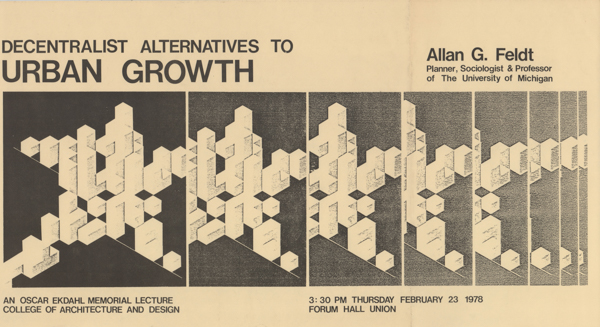
Academic and Professional Career:
Feldt's academic journey led him to graduate school at the University of Michigan, where he received a Ph.D. in Sociology in 1963, specializing in Human Ecology and Demography. He began his professional career as an Assistant Professor of Sociology and City and Regional Planning at Cornell University. During his time at Cornell, he also served on the Ithaca Planning Commission and as an alderman.
In 1971, Feldt joined the University of Michigan as an Associate Professor of Urban and Regional Planning, later becoming a full Professor until his retirement in 1994. He made significant contributions to the field of urban planning, particularly in the areas of simulation games for urban growth and development. His creation, CLUG (Community Land Use Game), became widely utilized in universities and colleges globally.
Contributions and Awards:
Throughout his career, Feldt published numerous papers and received accolades for his teaching, including the Urban Planning Educator of the Year award from the American Collegiate Schools of Planning (ACSAP) in 1995. He mentored and trained numerous doctoral students, many of whom went on to lead departments of Urban Planning and contribute significantly to society.
Personal Life and Legacy:
Allan Feldt's personal life was marked by a deep commitment to learning, teaching, and community service. He cherished his family, including his daughters Linda Diane and Laurie Karen, grandchildren, and great-grandson. After his wife Barbara's passing and his retirement, Feldt found companionship with fellow pianist Kathryn West.
In his later years, Feldt remained active in volunteer work, particularly assisting older adults with transportation and hearing loss. He reflected on his life and legacy, expressing satisfaction with his contributions and a readiness for his journey's end. Allan Gunnar Feldt's impact on urban planning education and practice continues to resonate, leaving a lasting legacy in the field.
Title: The Reintegration of Architecture and Art: Proposals for Ornament and the Creation of New Jobs in the Built Environment
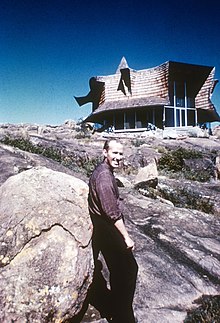 Herb Greene (born Herbert Ronald Greenberg in 1929)
Herb Greene (born Herbert Ronald Greenberg in 1929)
An American architect, artist, author, and educator renowned for his original interpretation of organic design principles. He is best known for his innovative contributions to architecture and art, particularly his experimental approach to form, materials, and spatial relationships.
Early Life and Education
Herbert Ronald Greenberg was born in Oneonta, New York, in 1929. He began his

architectural journey at Syracuse University but later transferred to the University of Oklahoma under the mentorship of modernist architect Bruce Goff. Greenberg worked alongside Goff, contributing to architectural drawings now housed in The Art Institute of Chicago's Archival Collection.
Career and Contributions
After working with John Lautner in Los Angeles and Joseph Krakower in Houston, Greenberg returned to the University of Oklahoma in 1957. Alongside Bruce Goff and Mendel Glickman, he played a pivotal role in developing the American School of architecture. This curriculum emphasized creativity, organic forms, and experimentation, drawing inspiration from diverse sources such as Native American designs and non-western cultures.
One of Greenberg's notable achievements is The Prairie House, completed in 1961 in Norman, Oklahoma. This modernist residence showcased smart architectural concepts ahead of its time, including passive design, energy efficiency, and integration with the natural environment.
In 1964, Greenberg became a professor at the University of Kentucky, where he taught for 18 years. His designs emphasized client-centered regional architecture, integrating historical references and personal objects into meaningful design relationships.
Artistic Practice and Legacy
Apart from his architectural work, Herb Greene's artistic practice spans six decades, exploring the evolution of perception and associative meaning. He drew influence from philosophical concepts and biological constructs, reflecting in his paintings housed in private collections and The Art Institute of Chicago.
Green's architectural and artistic legacy continues to inspire. His works have been exhibited nationally and internationally, showcasing his original concepts, organic design principles, and deep connections to landscape and culture.
Selected Works and Publications
- Southwest Bell Offices, Houston, Texas (1954)
- The Prairie House, Norman, Oklahoma (1960-1961)
- Unitarian Church, Lexington, Kentucky (1965)
- "Mind and Image: An Essay on Art and Architecture" (1976)
- "Building to Last, Architecture as Ongoing Art" (1981)
- "Painting the Mental Continuum: Perception and Meaning in the Making" (2003)
- "Generations: Six Decades of Collage Art and Architecture, Generated with Perspectives from Science" (2015)
Herb Greene's impact on architecture, art, and education reflects his commitment to innovation, sustainability, and the exploration of human perception and experience.
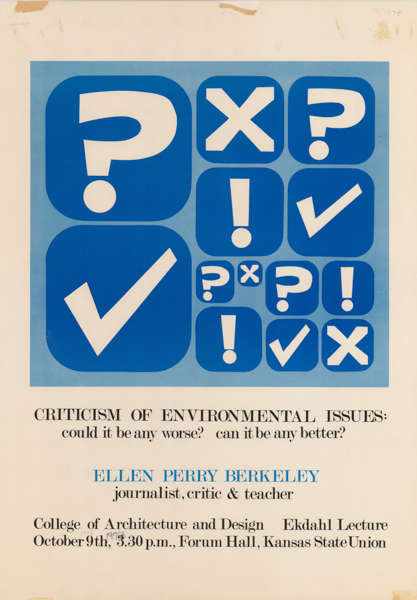 Title: Criticism of Environmental Issues: could it be any worse? can it be any better?
Title: Criticism of Environmental Issues: could it be any worse? can it be any better?
Ellen Berkeley is an accomplished writer, editor, and educator with a diverse career spanning several decades. Her contributions to literature, architecture, and education have left a lasting impact on various fields.
Early Life and Career
Ellen Berkeley began her career as a senior editor at prominent architectural publications, including Architectural Forum and Architecture Plus. Her editorial work showcased her talent for shaping compelling narratives and insightful discussions within the realm of architecture and design.
Literary Contributions
Berkeley's literary journey flourished as she transitioned into writing and publishing books. She authored three notable works:
- Maverick Cats (1982): This book delves into Berkeley's personal encounters with domestic cats that have adopted wild behaviors, incorporating research from around the world to provide a comprehensive exploration of these fascinating animals.
- Keith’s People (2003): A thriller novel that draws on recent information from Vietnam, showcasing Berkeley's skill in crafting gripping narratives based on real-world events.
- TNR: Past, Present and Future (2004): Berkeley explores the trap-neuter-return movement, offering detailed insights into efforts to control feral cat populations through humane methods.
Additionally, Berkeley served as an editor on two noteworthy books:
- Architecture: A Place for Women (1989): This book features 22 engaging discussions on the contributions of women in the field of architecture, highlighting their significant work and achievements.
- At Grandmother’s Table (2000): A historical compilation where 68 women share stories about their grandmothers and provide cherished heirloom recipes, offering a unique perspective on family heritage and culinary traditions.
Teaching and Freelance Work
Berkeley's expertise extends beyond writing and editing. She has taught courses at prestigious architectural schools, showcasing her commitment to educating and mentoring emerging talents in the field. Additionally, Berkeley writes freelance articles and essays on a wide range of subjects, showcasing her versatility as a writer and commentator.
Current Endeavors
In recent years, Ellen Berkeley has shifted her focus to teaching memoir writing closer to her home in Vermont. Her dedication to preserving personal stories and crafting compelling narratives continues to inspire both aspiring writers and seasoned professionals.
Ellen Berkeley's contributions to literature, architecture, and education reflect her passion for storytelling, advocacy for women's contributions in architecture, and commitment to sharing knowledge and experiences through writing and teaching.
Title: Prelude to Good Design
William Merriweather Peña
 Early Life and Education William Merriweather Peña, born on
Early Life and Education William Merriweather Peña, born on
February 10, 1919, in Laredo, Texas, was an American architect renowned for his contributions to architectural programming. He attended St. Augustine Catholic School and graduated from Laredo High School in 1937. Peña's academic journey led him to Texas A&M University, where he studied architecture and graduated with a bachelor's degree in 1942.
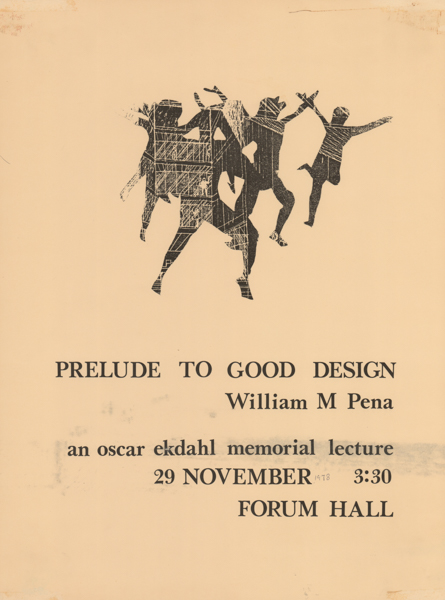
World War II and Military Service Peña's life took a significant turn during World War II when he served in the United States Army. Commissioned as a Second Lieutenant in 1942, he fought bravely in Europe and was involved in the Battle of the Bulge. Despite suffering a severe injury that resulted in the loss of his leg, Peña demonstrated remarkable courage and resilience. He received accolades for his service, including the Bronze Star Medal and Purple Heart.
Architectural Career After the war, Peña pursued a master's degree in architecture from Texas A&M University, graduating in 1948. He joined Caudill Rowlett Scott (CRS) architectural firm, where he became a partner in 1949. Peña's pioneering work in architectural programming, particularly his development of the Problem Seeking method, revolutionized the industry. This method emphasized collaboration between analysts and architects to ensure that designs met clients' goals and needs effectively.
Peña's influential book, "Problem Seeking: An architectural programming primer," co-authored with John Focke, became a standard textbook in the field. His contributions to architectural theory and practice earned him recognition as a Fellow of the American Institute of Architects.
Legacy and Awards Throughout his career, Peña received numerous awards and honors, including recognition as the Outstanding Alumnus of the Texas A&M College of Architecture and the Distinguished Alumnus Award from Texas A&M University. In 2013, he was presented with the Legion of Honour by the Consulate General of France, highlighting his contributions to architecture and his service during World War II.
Peña's dedication to architecture, innovative methodologies, and commitment to excellence continue to inspire architects and students in the field. He passed away on February 10, 2018, leaving behind a lasting legacy of architectural innovation and leadership.
Ekdahl Lectures 1979
Peter David Eisenman
 Early Life and Education Peter David Eisenman, born on August 11, 1932, in Newark, New Jersey, to Jewish parents, is a prominent American architect, writer, and professor. He attended Columbia High School in Maplewood, New Jersey, and later pursued architecture at Cornell University, where he graduated with a Bachelor of Architecture degree. Eisenman continued his academic journey with a Master of Architecture degree from
Early Life and Education Peter David Eisenman, born on August 11, 1932, in Newark, New Jersey, to Jewish parents, is a prominent American architect, writer, and professor. He attended Columbia High School in Maplewood, New Jersey, and later pursued architecture at Cornell University, where he graduated with a Bachelor of Architecture degree. Eisenman continued his academic journey with a Master of Architecture degree from  Columbia University and pursued MA and PhD degrees from the University of Cambridge. In recognition of his contributions, he received an honorary degree from Syracuse University School of Architecture in 2007.
Columbia University and pursued MA and PhD degrees from the University of Cambridge. In recognition of his contributions, he received an honorary degree from Syracuse University School of Architecture in 2007.
Career and Contributions Eisenman gained prominence as a member of the New York Five, a group of architects including Charles Gwathmey, John Hejduk, Richard Meier, and Michael Graves. Their work was showcased at a CASE Studies conference in 1969, marking a significant milestone in their careers. Eisenman's approach to architecture, characterized by high modernist and deconstructive designs, set him apart as a leading figure in the field.
Throughout his career, Eisenman has been involved in teaching and academia. He has taught at prestigious institutions such as Yale School of Architecture, Cooper Union School of Architecture (where he is Professor Emeritus), University of Cambridge, Harvard University, University of Pennsylvania, Princeton University School of Architecture, and the Ohio State University. Eisenman's contributions to architectural theory, particularly in formalist and deconstructive realms, have earned him recognition globally.
Notable Works Eisenman's portfolio includes a diverse range of projects, from single-family residences like his renowned "House" series to large-scale non-residential projects such as the Memorial to the Murdered Jews of Europe in Berlin and the City of Culture of Galicia in Spain. His work often reflects a formalist and deconstructive aesthetic, marked by fragmenting forms and innovative design approaches.
Awards and Recognition Eisenman's contributions to architecture have been acknowledged with several awards, including the National Design Award for Architecture in 2001 and the prestigious Wolf Prize in Arts in 2010.
Criticism Despite his acclaim, Eisenman's work has also faced criticism. Some critics have questioned aspects of his design choices, style, and perspective on architecture. However, Eisenman's impact on the architectural landscape remains significant, and his dialogues with cultural figures worldwide continue to shape architectural discourse.
Selected Works
- House I, Princeton, New Jersey, 1968
- Memorial to the Murdered Jews of Europe, Berlin, 2005
- State Farm Stadium, Glendale, Arizona, 2006
- City of Culture of Galicia, Santiago de Compostela, Galicia, Spain, 1999
Eisenman's legacy as an architect, writer, and educator continues to inspire and influence the field of architecture globally.